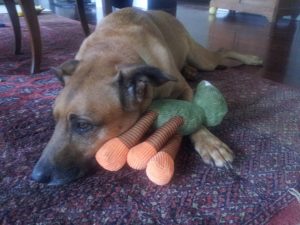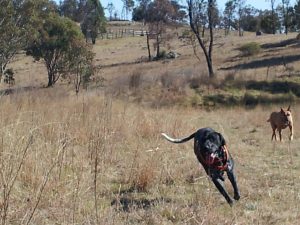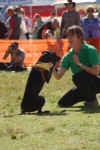I define a ‘good’ dog as a dog who is considered part of the family, can stay home alone if necessary but goes places if possible, lives in the house, goes on holidays, gets enough mental and physical stimulation, is ‘cool, calm and collected’ most of the time, takes changes like moving or an new addition to the family in his stride and most important spends his entire life with one owner.
As most professionals in the pet industry I try to be an advocate for the dogs and puppies I meet in training.
However, a survey in Australia (2009) produced some interesting results:
“In summary, the ideal dog in Australia is de-sexed, has short/straight hair, is of medium size (10–20 kg), is acquired as a puppy, and requires between 16 and 30 min exercise per day and between 1 and 15 min grooming per week. The ‘‘ideal dog’’ is also safe with children, housetrained, healthy, comes when called, does not escape the property, is not destructive when left alone, lives until at least 10 years old, and is obedient friendly and affectionate.”
That is a little scary, especially the part about the daily exercise, I personally do not know too many puppies or dogs who are happy with 16 to 30 minutes exercise per day. This is more suitable for a goldfish.
Basically what families want is a low maintenance, good natured, adaptable, calm and friendly dog. Some of these expectations are contradicting: We want them to be affectionate but also expect them to be home alone all day. They should come when called but we only want to give them 16 to 30 minutes of exercise a day. They should be safe with children and not destructive but they spend a lot of time on their own. Big ask isn’t it?
A lot of it is related to breeding and choice of the individual dog but I will leave this for another day.
But what about dog training classes? Do current puppy and dog training classes prepare the dogs for this life? Do we really teach what today’s families want from their pets?
A lot of time in an average dog training class is spent teaching ‘obedience’: stay, leave it, heel, sit, com, drop. Are these behaviours essential for the modern pet dog? Probably not as essential as we trainers like to think.
If we translated the research we should ‘teach’:
- home alone
- house training
- appropriate interaction with children
- dealing with strangers and coffee shops
- come when called
- social with other dogs (anecdotal evidence suggests that a lot of dog owners perceive the dog park as a great way of exercising their dogs)
- affection.
Lets start with home alone: Can we teach that in class? Probably not but we can start putting relaxation on cue. While this is unlikely to be perfect in class, owners need information on how to do it. A good way to start is playing a game like tug for a few seconds, stop the game ask for a calm behaviour (like lie down) and reward this with food and calm voice. Play again, then ask for calm again. It sometimes helps to teach the dog to put the head down (which in itself is a cute trick). Teaching a sit and lie down has its place in this context. Puppies need to learn to be on their own and even more important, enjoy their own company. Again this is not a skill that can be taught in class but if the owners get the right information it will be much easier. Up to date information for crate training and enrichment are a must for our classes.
House training: This is part of most puppy pre schools and a lot of good information is available.
Safety around children: Yes we can teach our puppy a ‘leave it’ cue but will this make her safe if a child approaches when she eats her bone? Probably not, but if a lot of exchanging or food bowl exercises are done, then the dog might be safe. If every time you need to take something away from the puppy you exchange for something more valuable, then giving up things becomes ‘second nature’. If you only teach ‘leave it’ the dog might still tense up, get stressed and potentially protect the resource. While dogs deserve to eat in peace a simple food bowl exercise can prevent a lot of problems later. If you teach your dog that your hands near the food bowl bring more food, the dog will learn that hands close to the bowl are a good thing.
Dealing with strangers and new places: Only a very limited part of socialization can be done in class. However, exposure to new things like tunnels, hats, toys, skate boards etc and creating a positive association can be done in class and will demonstrate proper socialization. Information and checklists on socialization are another must for dog training classes especially puppy pre schools.
Come when called: This is one thing we can easily teach in class and it should be done in a fun and rewarding way for dogs and owners. While the concept is easy, we often fail to explain some of the more important points. It is important to make ‘come’ rewarding every single time, at least in the beginning, and to never call the dog when you need to do something unpleasant (nail clipping, bath time, come inside etc). For these situations go and get the dog in a calm and friendly way. Pay handsomely and pay some more for a great recall. Jack pots increase motivation. Please do not ask your dog to sit when she comes, this can be very demotivating.
Affectionate: Again, affection per se cannot be taught but fun training,
like tricks can and will improve the relationship. The owners have fun and love their dogs for being ‘smart’ and the dogs engage more with their owners because the interaction is rewarding. A few easy tricks can make all the difference on how the dog is perceived.
Social with other dogs: Like other trainers I am no big fan of the dog park, however, for many owners this is a great part of being a dog owner. They do not care if we trainers agree or not, they want their dog to be social with other dogs. The best way to do this is carefully controlled off leash interaction at a young age and before the widow of socialization closes.
While some of the good old obedience skills certainly still have a place in our dog training classes, we need to adjust our curriculum to the changing needs of our clients, humans and dogs. A lot of the skills owners define as essential are not traditional obedience skills but social skills for their dogs that require owner education rather than dog training. This changes the role of the dog trainer from training dogs to educating owners.
This means that not only the skill set of dogs is changing but the skill set of dog trainers, too. This might be more difficult for some dogs and some trainers.




